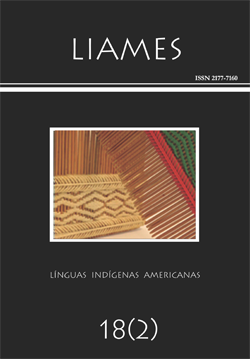Abstract
The lexicon of Bora (ISO 639-3: boa) body-parts presents two interesting characteristics. The first one is the polysemy of some words. In some cases, the meaning of one element extends to another or is linked to denote another entity. Hence, words like ihbáu means 'abdomen'. While used to denote this part of the body, it is also used to signal that a person is overweight. Likewise, it can also be used to indicate 'hill', 'mountain' or 'elevation'. Similarly, the word bájui means 'back', but it is also used to indicate the 'row of mountains' or 'mountain range'. Just as these processes of resemantization occur, there is a process of nominal derivation with the change of tone in the Bora lexicon. In this language, the change of tone within a word derives in a pejorative form of the root. For instance, the word núúmiho means ‘ear’. Nevertheless, the switch of its tone to the penultimate syllable changes its meaning. The new word nuumího means now ‘gossipmaker’. In the same way, this process occurs with the word íwahji ‘tooth’, with the tone derivation it becomes iwáhji and means ‘toothless’. This process, although not is exclusive to body parts, turns out to be very productive with this particular lexicon.
References
Aikhenvald, Alexandra Y. (2012). Languages of the Amazon. Oxford: Oxford University Press.
Chirif, Alberto (2014). Pueblo de la yuca brava. Historia y culinaria. Copenhague, Lima y Vaud: IWGIA, IBC, Nouvelle Plànete.
Díaz Peña, Hilario (2017). No estoy viajando callado: historia de vida de un maestro bora. Tsá cúúvéhullére o péhíjkyatúne. Luis Andrade, Enrique Delgado, Susana Frisancho & Andrés Napurí (eds.) Lima: Fondo Editorial de la Pontificia Universidad Católica del Perú. e-book, disponible en:
http://www.fondoeditorial.pucp.edu.pe/ebooks/481-ebook-gratuito-no-estoy-viajando-callado.html
Napurí, Andrés (2015). Breve caracterización fonológica de la lengua bora. Lengua y sociedad 15(2): 15-34.
Napurí, Andrés (2016). Revitalization of the Bora language. En Peter Trifonas y Themistoklis Aravossitas (eds.). Handbook of Research and Practice in Heritage Language Education, pp. 789–801. New York: Springer International Handbook. doi: 10.1007/978-3-319-38893-9_24-1
Landaburu, Jon (2001). Clasificación de las lenguas indígenas de Colombia. En María Stella González de Pérez y María Luisa Rodríguez de Montes (eds.). Lenguas indígenas de Colombia: una visión descriptiva, pp. 25-48. Bogotá: Instituto Caro y Cuervo.
Parker, Steve (2001). The acoustic qualities of Bora vowels. Phonetica 58: 179-195. doi:10.1159/000056198
Seifart, Frank (2005). The structure and use of shape-based noun classes in Miraña (North West Amazon) (Tesis de doctorado en Lingüística). Nimega: Radboud Universiteit Nijmegen. Disponible en:
Seifart, Frank; Echeverri, Juan Álvaro (2015). Proto Bora-Muinane. LIAMES - Línguas Indígenas Americanas 15(2): 279-311. Disponible en:
https://periodicos.sbu.unicamp.br/ojs/index.php/liames/article/view/8642303
Thiesen, Wesley; Weber, David (2012). A grammar of Bora with special attention to tone. Dallas: SIL International. Disponible en:
Thiesen, Wesley (1996). Gramática del idioma bora. Lima: Instituto Lingüístico de Verano y Ministerio de Educación. Disponible en:
Vengochea, Consuelo de (2003). Análisis del nombre a partir del léxico del cuerpo humano en la lengua muinane. Forma y Función 16: 265-291. Disponible en:
https://revistas.unal.edu.co/index.php/formayfuncion/article/viewFile/17273/18116
Vengochea, Consuelo de (2012). Catégorisation lexicale en Muinane: Amazonie Colombienne (Tesis de doctorado en Lingüística). Toulouse: Université Toulouse le Mirail. Disponible en: https://tel.archives-ouvertes.fr/tel-00796760/document
Weber, David; Thiesen, Wesley (2001). A synopsis of Bora tone. Work papers of the Summer Institute of Linguistics, University of North Dakota Session 45: 1-23. Disponible en:
Weber, David (2002). The structural status of Bora classifiers. Work papers of the Summer Institute of Linguistics, University of North Dakota Session 46: 1-8. Disponible en: http://arts-sciences.und.edu/summer-institute-of-linguistics/work-papers/_files/docs/2002-weber.pdf
Wojtylak, Katarzyna I. (2017) A grammar of Murui (Bue). A witotan language of North Amazonia (Tesis de doctorado en Lingüística). Queensland: James Cook University. Disponible en: https://researchonline.jcu.edu.au/51983/
Wojtylak, Katarzyna I. (2018). Evidentiality in Boran and Witotoan languages. In Alexandra Aikhenvald Y. (ed.). The Oxford Handbook in Evidentiality, pp. 388-408. Oxford: Oxford University Press.
The LIAMES: Línguas Indígenas Americanas uses the Creative Commons license (CC), thus preserving the integrity of the articles in an open access environment.



